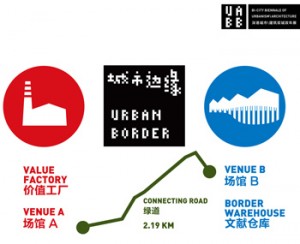2013 Bi-City Biennale of Urbanism\Architecture (Shenzhen)
December 6, 2013–February 28, 2014
An old Shenzhen glass factory will first change. Spearheaded by Team Ole Bouman, one of the UABB(SZ)’s two curatorial teams, the project adhered to Curator, Creative Director Ole Bouman’s manifesto statement of “Biennale as risk.” The revitalisation effort not only provides a unique and functional exhibition space for the Biennale but it reclaims a piece of heritage and history. As a broader objective, the makeover is also a step in redefining Shenzhen’s identity. In completing the urban intervention, Mr. Bouman now calls it a Value Factory to manufacture ideas and knowledge.
Built in 1986, the former Guangdong Float Glass Factory had been derelict since 2009. The metamorphosis began in May as an international collaboration effort when a dozen emerging international architects were invited to design for the factory transformation. Started in the middle July, the whole transformation process has been completed in only three months.
Already, the Value Factory appears to be achieving its goals by developing strong alliances with partners both local and regional, and from all over the world. Among them include globally renowned cultural institutions like Victoria & Albert Museum (V&A), MAXXI, OMA, Droog Design, International Architecture Biennale of São Paulo, MIT, MoMA New York, and the Berlage.
As a venue for the 2013UABB(SZ), the Value Factory, along with the other exhibition site the Border Warehouse (Old Warehouse at Shekou Ferry Terminal), has elevated it from just design and architecture installations to a significant cultural and social event relevant to urban sustainability and regular citizens.
The exhibition in Border Warehouse, presented by Curators and Academic Directors Li Xiangning and Jeffrey Johnson, consists of a five-part exhibition. In the words of Li and Johnson, it examines multiple historical readings of “cities.” They seek to document critical themes pertaining to urban borders. Their exhibition will include an analysis of the historical evolution of borders, and an exploration of theoretical interpretations by contemporary practitioners.
In the Border Timeline Documentary section, 15 architects from 15 different global cities will contribute individual city case studies. Each participant will produce a succinct essays and supplementary images examining past, present and future urban “border” conditions.
World renowned architects and designers will offer their visions for urban boundaries in the section entitled Crossing Border Case Studies. Highlights include German architect Juergen Mayer’s examination of the use of silhouettes as border and landscape in border.scape, and the recent editor of Domus, Joseph Grima, in collaboration with Tamar Shafrir, looking at the short-lived commercial sea platform Isolla della rose off Rimini.
A more psychological and cultural paradigm is explored in the section Exploring the Social Boundary. Of special note is Professor Lou Yongqi, a sustainability proponent who investigates the issue in his display, “Designing the Urban-Rural Interaction.”
The two other sections of the exhibition are National and Regional Pavilions as various countries showcase their talents, the Border Video Gallery will feature five movies and four videos by artists.
Promoting innovation in the disciplines of architecture and urban issues, the UABB(SZ) not only seeks to bring academic accomplishment into the spotlight but to look beyond current global trends and towards the future, all the while promoting the synergy of Western and Chinese innovative urbanism\architectural ideas.


